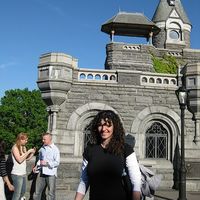Wants to Meet Up
- Last login about 4 years ago
Join Couchsurfing to see Marijana’s full profile.
Overview
About Me
CURRENT MISSION
Get some rest!
ABOUT ME
Let's make it a cliche: I love to travel, and I love meeting new people from different cultures. I love having fun and I love to laugh. I want to see the world in peace and I want to swim with dolphins!
And now something real: If you're not a morning person, I can be a bit annoying, since I have a smile on my face from the moment I open my eyes... And people say I talk a lot... didn't notice that one ;)
PHILOSOPHY
Always be happy, but never content.
Interests
people, music, movies, computers (yes, I'm a geek) :)
- movies
- traveling
- music
- tennis
- swimming
- history
- parks
- lakes
Music, Movies, and Books
U2, Dave Matthews Band, Beatles
If tomorrow ever comes
One Amazing Thing I’ve Done
There are so many amazing things around us every day. But till now the one thing that I can never forget is the first time I walked into Machu Picchu. The mix of history and some special energy overwhelmed me. I spent the whole day there and it wasn't enough. The stories I heard, the things I've seen. I can't even imagine how glorious it was in its full glory.
Teach, Learn, Share
Lesson number one: Varazdin was capital of Croatia from 1767 till 1776, when after a big fire in Varazdin everything was moved to Zagreb.
Lesson number two: The necktie was invented in Croatia and is called a “cravat,” which is derived from the word “Croat.”
Lesson number three: Croatia has eight national parks: Brijuni, Kornati, Krka, Mljet, Paklenica, Plitvice Lakes, Risnjak and North Velebit. In my personal opinion this is a lot for our small country. :)
Lesson number four: The name of the Croatian monetary unit is KUNA (KN), which has 100 lipas. The meaning of KUNA is - a marten - its skin had been used as a unit in trade. The earliest mention we know of is from the year 1018, on the island of Cres. The first known use of kuna on a Croatian coin goes as far back as 1256, when a local currency displaying kuna was issued in Slavonia.
Lesson number five: The Croatian National Emblems are: the tricolour flag (red, white, blue, arranged in this order perpendicularly to the staff), and the coat of arms (13 red squares and 12 silver squares arranged intermittently in a 5 times 5 pattern).On the top of the coat of arms there is a crown composed of five regional symbols representing: the oldest known Croatian coat of arms, Dubrovnik, Dalmatia, Istria and Slavonia.
Lesson number six: Croatia has the smallest and loveliest town in the world - having city walls, two streets, two churches and 23 inhabitants - Hum, in the Istrian peninsula
Lesson number seven: Croatian tennis player Goran Ivanisevic won Wimbledon in 2001 after entering the tournament on a wild card.
Lesson number eight: Croatian young people can vote at the age of 16 if they have a job but must wait until 18 if they are unemployed.
Lesson number nine (a bit of history): Croatia was founded in the first half of 7th century, on the ruins of the Roman Empire. It gained independence from Austria-Hungary in October 1918 and declared its independence from Yugoslavia in 1991.
Lesson number ten: Croatia's Adriatic coast is home to over 1,000 islands and numerous coastal towns.
Lesson number eleven: the most preserved Roman amphitheater is located in Pula which is the only one in the world with all 3 rows completely preserved
Lesson number twelve: Croats had their own alphabet called “glagoljica” (eng. Glagolitic) that was in everyday use until the 18th century
Fun fact about Split: As is probably quite known, Split is a home to the vast palace of Emperor Diocletian. The city’s original name was Spalato, a word which ancient Romans used to describe a large palace, while Italians used it for the complete opposite – a small palace. To see which fits better, you will have to see the site yourself. The local plant known as brnistra is called aspalathos in Greek, so it probably had its share of influence on Split’s name.
Countries I’ve Visited
Bolivia, Finland, France, Greece, Hungary, Ireland, Italy, Peru, Spain, Turkey, United Kingdom, United States
Countries I’ve Lived In
Croatia, Ireland
Old School Badges
-

3 Vouches


